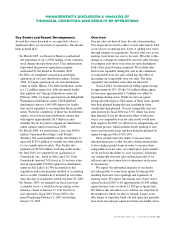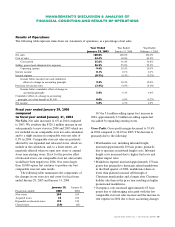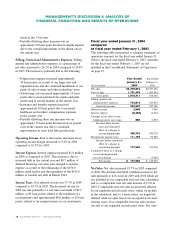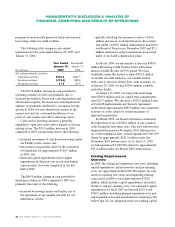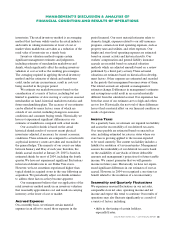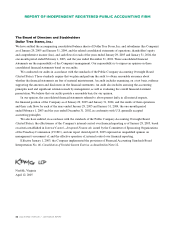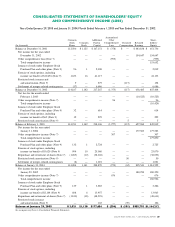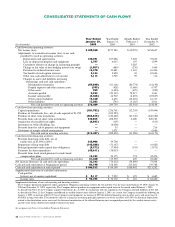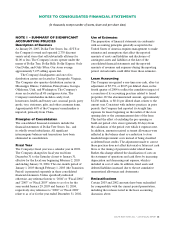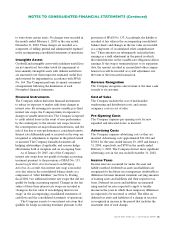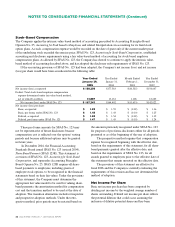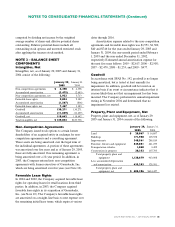Dollar Tree 2004 Annual Report Download - page 29
Download and view the complete annual report
Please find page 29 of the 2004 Dollar Tree annual report below. You can navigate through the pages in the report by either clicking on the pages listed below, or by using the keyword search tool below to find specific information within the annual report.
DOLLAR TREE STORES, INC. • 2004 ANNUAL REPORT 25
statement is a revision of SFAS No. 123, Accounting for
Stock-Based Compensation, and supersedes Accounting
Principles Board Opinion No. 25, Accounting for Stock
Issued to Employees. SFAS 123R requires all share-based
payments to employees, including grants of employee
stock options, to be recognized in the financial statements
based on their fair values. Under the provisions of this
statement, we must determine the appropriate fair value
model to be used for valuing share-based payments, the
amortization method for compensation cost and the
transition method to be used at the date of adoption. The
transition alternatives include retrospective and prospective
adoption methods. Under the retrospective method, prior
periods may be restated based on the amounts previously
recognized under SFAS No. 123 for purposes of pro
forma disclosures (see Note 1 to the consolidated financial
statements) either for all periods presented or as of the
beginning of the year of adoption.
The prospective method requires that compensation
expense be recognized beginning with the effective date,
based on the requirements of this statement, for all share-
based payments granted after the effective date, and based
on the requirements of SFAS No. 123, for all awards
granted to employees prior to the effective date of this
statement that remain unvested on the effective date.
The provisions of this statement are effective for
fiscal 2006 and we are currently evaluating the
requirements of this revision and have not determined
our method of adoption.
QUANTITATIVE AND QUALITATIVE
DISCLOSURES ABOUT MARKET RISK
We are exposed to various types of market risk in the
normal course of our business, including the impact of
interest rate changes and foreign currency rate
fluctuations. We may enter into interest rate swaps to
manage exposure to interest rate changes, and we may
employ other risk management strategies, including the
use of foreign currency forward contracts. We do not
enter into derivative instruments for any purpose other
than cash flow hedging purposes and we do not hold
derivative instruments for trading purposes.
Interest Rate Risk
We use variable-rate debt to finance certain of our
operations and capital improvements. These obligations
expose us to variability in interest payments due to
changes in interest rates. If interest rates increase, interest
expense increases. Conversely, if interest rates decrease,
interest expense also decreases. We believe it is beneficial
to limit the variability of our interest payments.
To meet this objective, we entered into derivative
instruments in the form of interest rate swaps to manage
fluctuations in cash flows resulting from changes in the
variable-interest rates on the obligations. The interest rate
swaps reduce the interest rate exposure on these variable-
rate obligations. Under the interest rate swap, we pay the
bank at a fixed-rate and receive variable-interest at a rate
approximating the variable-rate on the obligation, thereby
MANAGEMENT’S DISCUSSION & ANALYSIS OF
FINANCIAL CONDITION AND RESULTS OF OPERATIONS
creating the economic equivalent of a fixed-rate obligation. Under the $19.0 million interest rate swap, no payments are
made by parties under the swap for monthly periods in which the variable-interest rate is greater than the predetermined
knock-out rate.
The following table summarizes the financial terms of our interest rate swap agreements and the fair value of each
interest rate swap at January 29, 2005:
Hedging Receive Pay Knock-out Fair
Instrument Variable Fixed Rate Expiration Value
$19.0 million interest rate swap LIBOR 4.88% 7.75% 4/1/09 ($0.9 million)
$25.0 million interest rate swap LIBOR 5.43% N/A 3/12/06 ($0.6 million)
Hypothetically, a 1% change in interest rates results in approximately a $0.4 million change in the amount paid or
received under the terms of the interest rate swap agreements on an annual basis. Due to many factors, management is
not able to predict the changes in fair value of our interest rate swaps. The fair values are the estimated amounts we
would pay or receive to terminate the agreements as of the reporting date. These fair values are obtained from an outside
financial institution.


